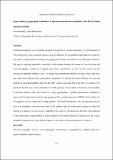Files in this item
Space matters : geographic variability of electoral turnout determinants in the 2012 London mayoral election
Item metadata
| dc.contributor.author | Mansley, Ewan | |
| dc.contributor.author | Demsar, Urska | |
| dc.date.accessioned | 2017-04-22T23:33:07Z | |
| dc.date.available | 2017-04-22T23:33:07Z | |
| dc.date.issued | 2015 | |
| dc.identifier | 222090343 | |
| dc.identifier | e19b8292-d1f8-43ed-9c70-65c2c9b1c844 | |
| dc.identifier | 84945135143 | |
| dc.identifier | 000367276800031 | |
| dc.identifier.citation | Mansley , E & Demsar , U 2015 , ' Space matters : geographic variability of electoral turnout determinants in the 2012 London mayoral election ' , Electoral Studies , vol. In press . https://doi.org/10.1016/j.electstud.2015.10.003 | en |
| dc.identifier.issn | 0261-3794 | |
| dc.identifier.other | ORCID: /0000-0001-7791-2807/work/48516846 | |
| dc.identifier.uri | https://hdl.handle.net/10023/10642 | |
| dc.description.abstract | Electoral participation is an important measure of the health of a liberal democracy. The determinants of voter turnout have been examined across a range of elections, but geographical approaches are relatively rare and are mostly performed at large scale aggregations and for national elections. This paper addresses this gap by exploring geographic variability in relationships between the turnout at a local election and socio-demographic variables at a detailed spatial level. Specifically, we focus on the London mayoral election, an important element of the 21st century local government reform in Britain, which, until now, has seldom been analysed from a geographical perspective. By linking the turnout from the 2012 mayoral election to socio-demographic data from the 2011 Census and doing this at the level of London’s 625 wards, for the first time a more detailed picture of the spatially uneven nature of turnout is evidenced than in previous studies which have focused on larger aggregations, typically constituencies. Analysis is approached through spatial analysis using geographically weighted regression (GWR), which enables the investigation of local variations in voting patterns. The results demonstrate that electoral processes do vary over geographic space and that some of the variables that are traditionally assumed to affect the turnout in a specific way, do not do so uniformly over space or even change the direction to the opposite of the traditionally assumed affect in certain locations. Our findings present a starting point for a more detailed investigation as to why this heterogeneity exists and which social processes it relates to. | |
| dc.format.extent | 1090800 | |
| dc.language.iso | eng | |
| dc.relation.ispartof | Electoral Studies | en |
| dc.subject | Electoral geography | en |
| dc.subject | Turnout | en |
| dc.subject | Socio-demographic characteristics | en |
| dc.subject | Geographically Weighted Regression | en |
| dc.subject | Spatial variability | en |
| dc.subject | Spatial analysis | en |
| dc.subject | JA Political science (General) | en |
| dc.subject | 3rd-DAS | en |
| dc.subject.lcc | JA | en |
| dc.title | Space matters : geographic variability of electoral turnout determinants in the 2012 London mayoral election | en |
| dc.type | Journal article | en |
| dc.contributor.institution | University of St Andrews. Geography & Sustainable Development | en |
| dc.contributor.institution | University of St Andrews. Bell-Edwards Geographic Data Institute | en |
| dc.identifier.doi | 10.1016/j.electstud.2015.10.003 | |
| dc.description.status | Peer reviewed | en |
| dc.date.embargoedUntil | 2017-04-22 |
This item appears in the following Collection(s)
Items in the St Andrews Research Repository are protected by copyright, with all rights reserved, unless otherwise indicated.

